Why Is The UK So Hot? How Climate Change Is Impacting British Summers
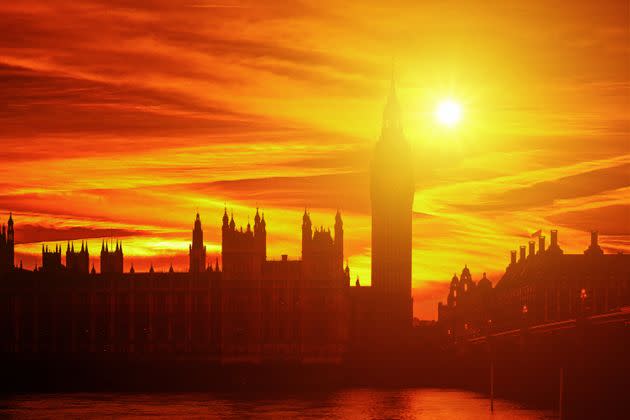
(Photo: Peter Zelei Images via Getty Images)
The UK reached its hottest temperature ever recorded earlier this month, with the heatwave climaxing at 40.3ºC in Lincolnshire.
The heat eclipsed the previous record from 2019, when a high of 38.7ºC was recorded in Cambridge and caused the Met Office to issue its first red extreme heat warning.
Early predictions suggest there may be a similarly intense heatwave reaching Britain again in August.
It’s enough to make the most avid sun worshippers pause for thought and ask: why is it so damn hot?
Well, the short answer is that a pressure system called the Azores High, which usually sits off Spain, has expanded and pushed further north, bringing hotter temperatures to the UK.
The longer answer is climate change. Because there’s a reason the Azores High (and other pressure systems) are changing. This isn’t “just summer”, but it will become the norm for summer if we don’t move to cut carbon emissions.
In fact, a new study suggests climate breakdown made the recent record heatwave 10 times more likely. Analysis by World Weather Attribution found that temperatures exceeded even those predicted by climate models.
Friederike Otto, a senior climate lecturer at the Grantham Institute for Climate Change, Imperial College London, said: “In Europe and other parts of the world we are seeing more and more record-breaking heatwaves causing extreme temperatures that have become hotter faster than in most climate models.
“It’s a worrying finding that suggests that if carbon emissions are not rapidly cut, the consequences of climate change on extreme heat in Europe, which already is extremely deadly, could be even worse than we previously thought.”
The study follows comments from Professor Penelope Endersby, chief executive at the Met Office, who confirmed: “These temperatures are unattainable in the UK without climate change, they just don’t appear.”
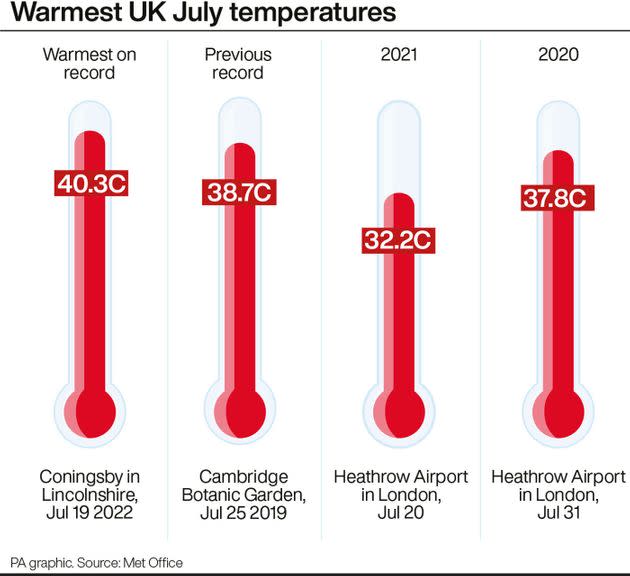
Warmest UK July temperatures. (Photo: PA Graphics via PA Graphics/Press Association Images)
How is human activity causing UK heatwaves?
To better understand the UK heatwave, let’s first go back to basics.
Climate change is defined by the United Nations as “long-term shifts in temperatures and weather patterns”. The earth’s climate naturally changes over time (we’ve had the Ice Age, after all). But human behaviour is accelerating changes at an increasingly rapid rate.
That’s because when we burn fossil fuels such as oil, gas, and coal we produce ‘greenhouse gases’, which are trapped around the earth like a warming blanket, causing it to heat up.
Greenhouse gas concentrations are at their highest levels in 2 million years and continue to rise. As a result, the earth is about 1.1°C warmer than it was in the 1800s – and it keeps getting hotter.
Climate change doesn’t just mean more heatwaves – it’s also responsible for wildfires, intense droughts, rising sea levels, flooding, melting polar ice, catastrophic storms and declining biodiversity.
Should we be worried about the UK heatwave?
The UK’s red weather alerts signify a threat to health and infrastructure, which is why it’s important to take precautions to stay cool.
Professor Hannah Cloke, natural hazards researcher at the University of Reading, said it should also be seen as “a wake-up call about the climate emergency”.
“Even as a climate scientist who studies this stuff, this is scary. This feels real,” she said as the mid-July heatwave took hold.
“We have had heatwaves in the UK before, but the intensity of heat that has been forecast, which will either break UK records or at least get very close, is enough to kill people and animals, damage property, and hobble the economy.
“Exactly one year on from the record floods in Germany, we should remember the lesson from that tragedy. Those floods were well forecast days in advance, but due to a range of failures in the chain of communication and action, people didn’t know what to do, and hundreds died. Heat kills more people than floods, and high ground from heat can be hard to find.”
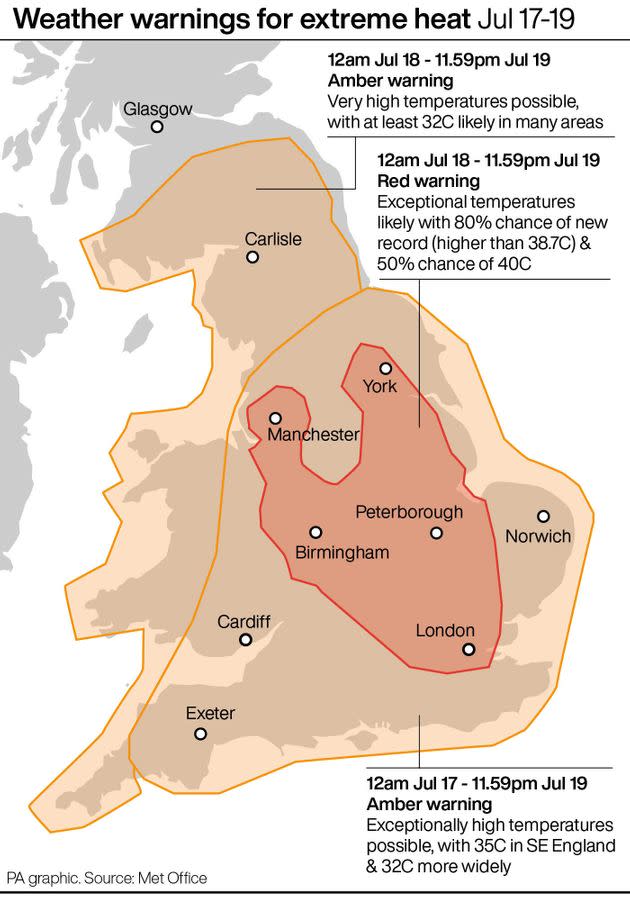
(Photo: via PA Graphics/Press Association Images)
Will all our summers be this hot now?
Not all summers will be this hot, but we will see these hot temperatures more and more frequently, according to Dr Nikos Christidis, who has researched the links between climate change and UK weather.
“Climate change has already influenced the likelihood of temperature extremes in the UK,” he says.
“The chances of seeing 40°C days in the UK could be as much as 10 times more likely in the current climate than under a natural climate unaffected by human influence.
“The likelihood of exceeding 40°C anywhere in the UK in a given year has also been rapidly increasing, and, even with current pledges on emissions reductions, such extremes could be taking place every 15 years in the climate of 2100.”
How will the UK cope with rising temperatures?
Some schools closed in July, while rail services are heavily restricted during the UK heatwave. On social media, you’ll find many people pointing out that other countries deal with temperatures exceeding 40ºC on a yearly basis, so why can’t we?
Well, our infrastructure simply isn’t designed for it. Our houses are designed to keep heat in, for example, whereas in typically hotter countries, the opposite is true. That might have to change in the near future.
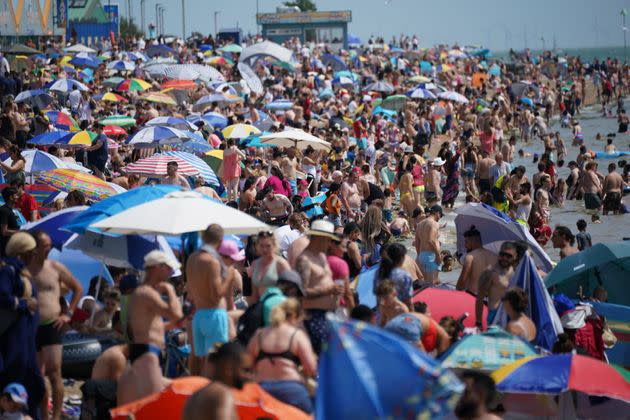
People relax on the beach at Southend-on-Sea on the Thames Estuary in Essex. Temperatures are predicted to hit 31C across central England on Sunday ahead of record-breaking highs next week. Picture date: Sunday July 17, 2022. (Photo: Yui Mok via PA Wire/PA Images)
Whoever becomes the next Prime Minister needs to keep the UK government’s promises on climate and nature.Katie White, WWF
“Our services and infrastructure are designed to cope with ‘normal’ weather, and many organisations have plans in place to deal with what they think of as ‘extreme’ conditions,” explains Nigel Arnell, professor of climate system science at the University of Reading.
“However, we’re seeing more and more examples of extremes, and we’ve also seen evidence that we’re not as well prepared as we thought – look back to Storm Arwen.
“In the short term, we need to make sure our emergency plans are fit for purpose, and that we can act on the good warnings we get from the Met Office. But we can’t keep on dealing with extremes in crisis mode. They’re happening more and more frequently, so we need to improve our resilience to extreme weather events.”
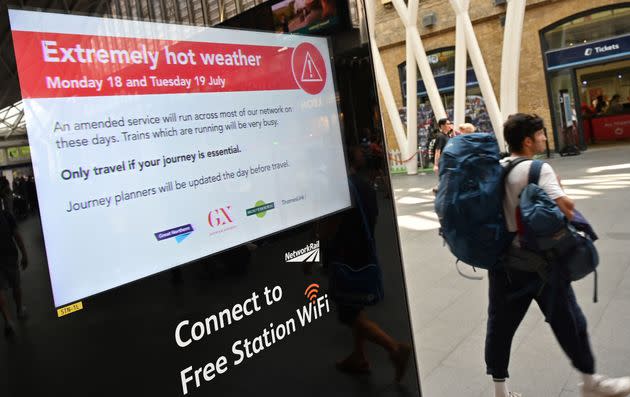
(Photo: JUSTIN TALLIS via AFP via Getty Images)
We need a change to building regulations and add more greenery to our cities to lower temperatures, says Professor Arnell.
“We will only make real progress when adaptation and resilience is given a high enough political priority,” he adds.
Of course, longer term we also need to cut carbon emissions too.
“The only way to limit global warming to the crucial goal of 1.5°C is to restore nature, slash emissions and invest in clean, renewable energy,” says Katie White, executive director of advocacy and campaigns at WWF.
“Whoever becomes the next Prime Minister needs to keep the UK government’s promises on climate and nature, and leadership candidates should outline how they plan to deliver.”
And something to remember...
Temperatures of 40ºC are to be taken seriously and are considered incredibly hot for the UK, but this is a global problem. In April, temperatures in Pakistan reached 49ºC and above 47ºC in parts of India as a spring heatwave descended across the nations, leading to at least 90 deaths.
As the trend continues, the UK may be able to adapt to cope, but the global picture remains concerning.
“Though developed countries produce most greenhouse gas emissions, developing countries are predicted to see most of the severe effects,” the Met Office says. “With fewer resources to adapt to these changes, the impact on people in developing countries is expected to be higher.”
This article originally appeared on HuffPost UK and has been updated.
Related...
UK National Heatwave Emergency Declared. Here's What That Means
How To Stay Cool In A Heatwave: All The Tips You Could Possibly Need
The Heatwave Hacks You Need To Cool Down When It's Boiling Outside
You Need To Watch Out For These Signs Of Heatstroke In Children
21 Tweets About Brits Trying (And Failing) To Work Through A Heatwave

 Yahoo News
Yahoo News 